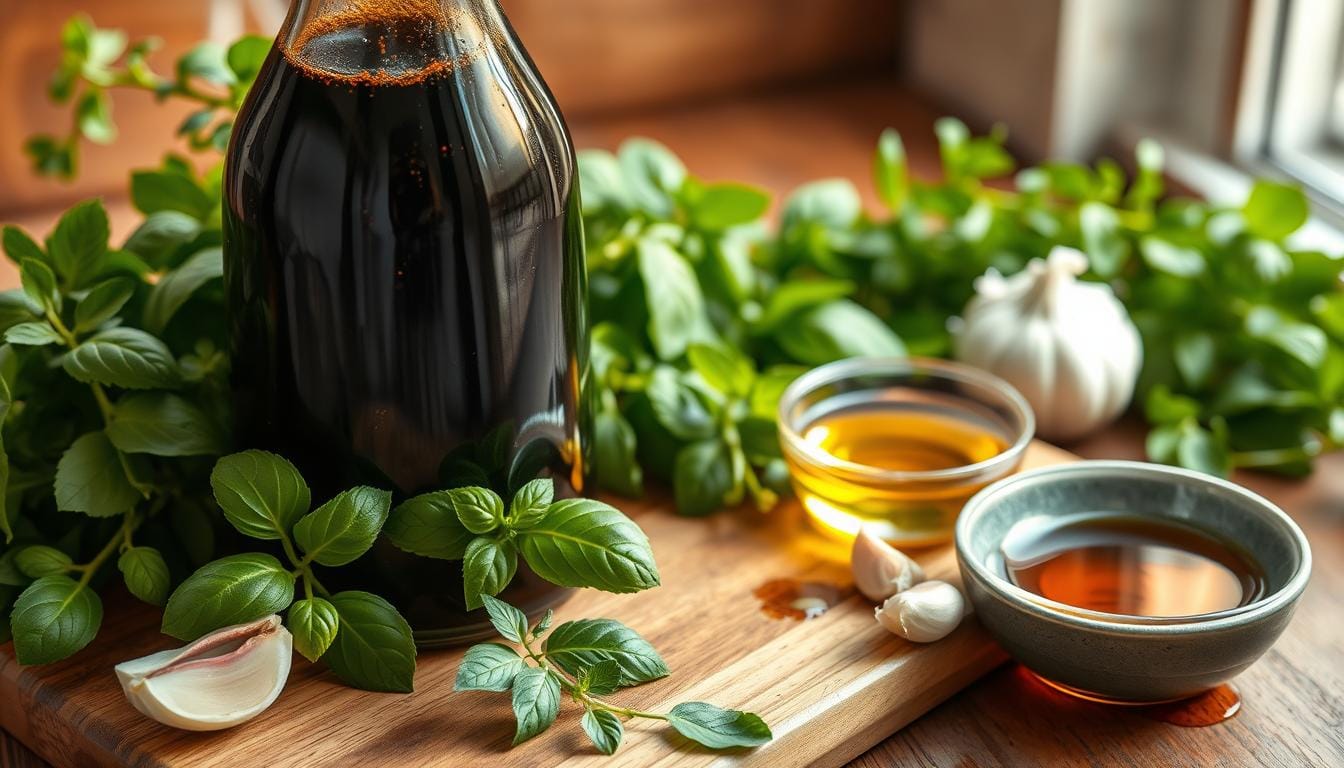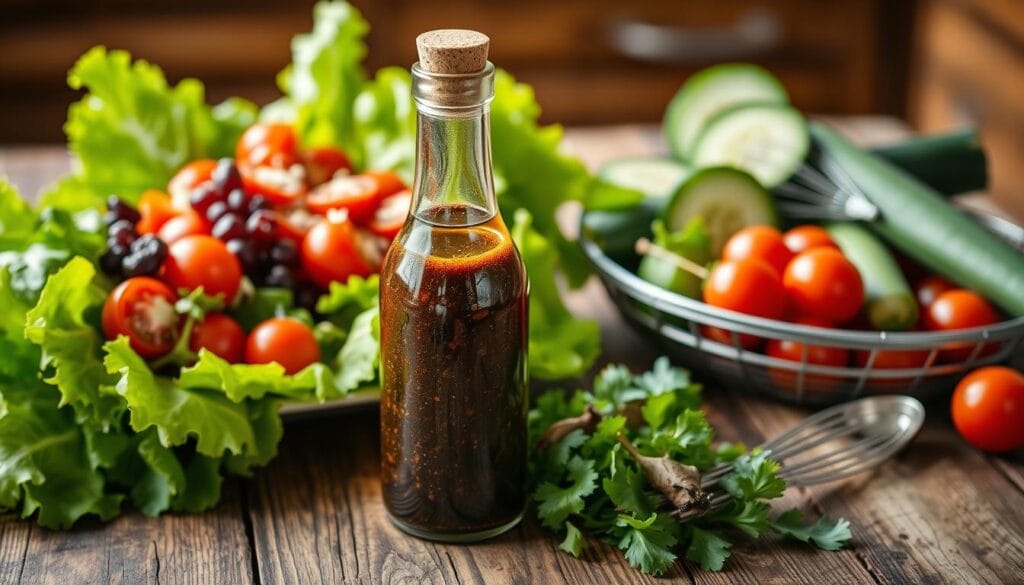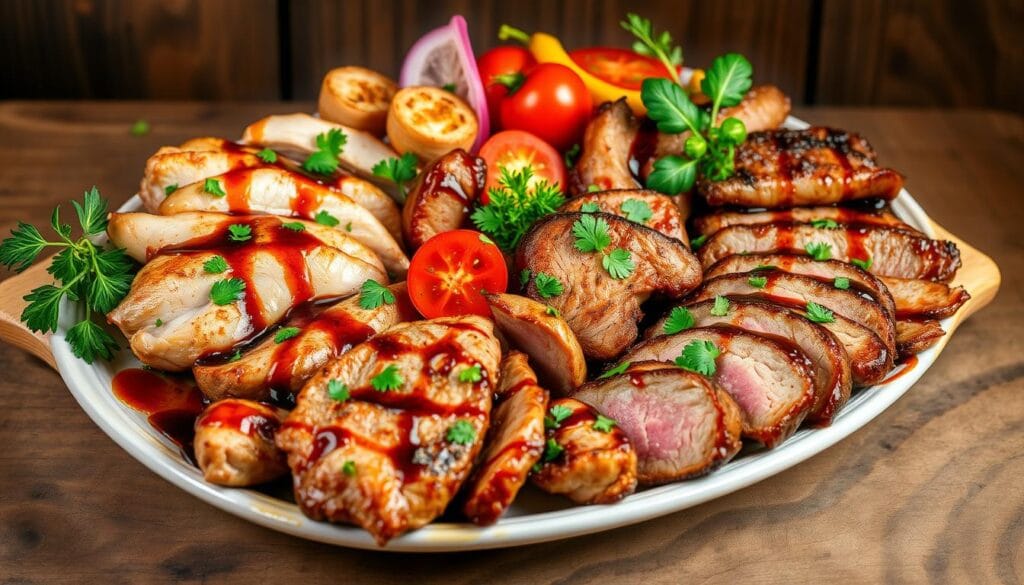As a busy parent, I often felt overwhelmed by salad dressing choices in the grocery aisle. But I found a secret that changed my weeknight meals. Homemade balsamic vinaigrette became a kitchen staple, making salads and roasted veggies taste amazing.
This dressing is special because of its quality ingredients. It has extra virgin olive oil, balsamic vinegar, Dijon mustard, and honey. The best part? It’s ready in under 5 minutes, perfect for busy cooks like me.
This recipe has changed my kitchen, turning simple salads into works of art. It adds flavor to veggies and protein dishes. Making my own dressing brings me joy and control over what I eat. Let’s explore the joy of homemade balsamic vinaigrette together.
What is Balsamic Vinaigrette?
Balsamic vinaigrette is a tasty dressing found in many kitchens. It’s made from balsamic vinegar and olive oil. This mix gives it a tangy, slightly sweet taste.
Definition and Origins
The word “balsamic” comes from Italian vinegar made from grape must. This vinegar is made by reducing grape juice over years. Balsamic vinaigrette is a modern twist, blending balsamic vinegar with other flavors.
Common Ingredients
- Balsamic vinegar
- Olive oil
- Dijon mustard
- Honey (optional)
- Garlic (optional)
- Salt and pepper
Health Benefits
Balsamic vinaigrette is good for you, thanks to olive oil. Olive oil has healthy fats that can lower cholesterol and heart disease risk. Balsamic vinegar also has antioxidants. Plus, it’s low in calories, with 2 tablespoons having about 81 calories.
“Balsamic vinaigrette is a delicious and versatile dressing that can elevate a simple salad or enhance a variety of dishes.”
Why Homemade is Better than Store-Bought
Homemade balsamic vinaigrette beats store-bought in many ways. It’s fresher, tastes better, and lets you control the ingredients. Plus, it’s cheaper to make your own homemade salad dressing.
Freshness and Flavor
Store-bought dressings often have preservatives and fake stuff. This can make them taste less fresh and less flavorful. But, making your own healthy salad topping means you pick the best ingredients. This way, you get a taste that’s vibrant and real.
Customization Options
When you make your own balsamic vinaigrette, you can change the flavors however you like. You can play with the vinegar and oil mix, add herbs and spices, or even throw in honey or garlic.
Cost-Effectiveness
Homemade homemade salad dressing is cheaper than buying it. You use common ingredients like balsamic vinegar and olive oil. These are things you likely already have at home, saving you money.
| Homemade Balsamic Vinaigrette | Store-Bought Balsamic Vinaigrette |
|---|---|
| Made with fresh, high-quality ingredients | May contain preservatives and artificial additives |
| Allows for customization of flavors | Limited flavor options |
| More cost-effective | Can be more expensive |
Choosing between homemade and store-bought balsamic vinaigrette depends on what you value most. Making your own at home means you get the best of freshness, flavor, and value. It’s a great way to enjoy a healthy salad topping that’s just right for you.
Essential Ingredients for Your Vinaigrette
Creating a tasty olive oil vinaigrette or a creamy balsamic vinegar dressing starts with the right ingredients. Let’s look at the key parts that make your homemade vinaigrette stand out.
Choosing the Right Balsamic Vinegar
The base of a great vinaigrette is the balsamic vinegar. Choose a high-quality, aged balsamic vinegar. It should have a thick texture and a sweet, complex flavor. The aging process makes the flavors stronger, creating a balanced dressing.
Selecting Quality Olive Oil
For vinaigrettes, use extra-virgin olive oil. It adds a rich feel and a fruity smell. Pick a bottle labeled “extra-virgin” from a trusted producer. This ensures the best taste and quality for your dressing.
Additional Flavor Enhancers
- Dijon mustard: It adds a tangy, binding element to the vinaigrette.
- Honey or maple syrup: A bit of sweetener balances the vinegar’s acidity.
- Garlic: Minced or crushed garlic adds depth and complexity.
- Shallots: Finely chopped shallots add a subtle, onion-like flavor.
The secret to a perfect olive oil vinaigrette or balsamic vinegar dressing is finding the right balance. By choosing quality ingredients and adding flavor enhancers, you can make a homemade vinaigrette that will enhance your salads and dishes.
| Ingredient | Amount | Nutritional Information (per serving) |
|---|---|---|
| Olive Oil | 1/2 cup |
|
| Dijon Mustard | 1 teaspoon |
|
| Balsamic Vinegar | 2 tablespoons |
|
| Honey | 4 tablespoons |
|
Basic Balsamic Vinaigrette Recipe
Making the perfect easy balsamic vinaigrette recipe at home is easy and fun. This homemade balsamic vinaigrette is fresh, tasty, and lets you pick the ingredients and flavors you like.
Step-by-Step Instructions
- In a medium bowl, mix 3 tablespoons of balsamic vinegar, 2 tablespoons of honey, 1/2 tablespoon of Dijon mustard, and 1 minced garlic clove.
- Slowly add 1/3 cup of good olive oil while whisking to mix it well.
- Add 1/4 teaspoon of salt and some freshly ground black pepper to taste.
- Keep whisking until the vinaigrette is smooth and creamy.
Tools You’ll Need
- A medium-sized mixing bowl
- A whisk or a small jar with a tight-fitting lid
- Measuring spoons
Tips for Perfect Consistency
To get the perfect consistency for your homemade balsamic vinaigrette, mix well. Whisk or shake hard to make sure the oil and vinegar mix well, creating a smooth dressing.
This basic easy balsamic vinaigrette recipe makes about 1 cup of dressing. It’s enough for 8 servings of salad or other dishes. You can store it in the fridge for up to 4 days, making it a great addition to your cooking.
Variations of Balsamic Vinaigrette
The classic balsamic vinaigrette is great, but you can also try many other flavors. You can make it sweeter, nuttier, bolder, or spicier. These changes can make your salads taste even better.
Honey Balsamic Vinaigrette
Adding honey to your balsamic vinaigrette makes it sweeter. This balances the vinegar’s acidity. It’s perfect for salads, fruit, and roasted veggies.
Garlic-Infused Version
Garlic can make your vinaigrette taste amazing. Just mix in some minced garlic. It adds a rich flavor to any salad or dish.
Herb-Infused Recipes
Herbs like basil, thyme, or rosemary can enhance your vinaigrette. They add a unique taste. This makes your vinaigrette great for many salads and veggie dishes.
| Vinaigrette Variation | Key Ingredients | Flavor Profile |
|---|---|---|
| Honey Balsamic | Balsamic vinegar, olive oil, honey | Sweet and tangy |
| Garlic-Infused | Balsamic vinegar, olive oil, garlic | Savory and robust |
| Herb-Infused | Balsamic vinegar, olive oil, fresh herbs | Aromatic and complex |
These balsamic vinaigrette variations let you play with flavors. You can make your own DIY salad dressing that you love. Whether you want it sweet, savory, or herby, you’ll find something great.
Storing Your Homemade Vinaigrette
Keeping your homemade balsamic vinaigrette fresh and flavorful is key. To keep your DIY salad dressing tasting great, follow these storage tips.
Best Storage Practices
Store your homemade balsamic vinaigrette in a clean, airtight glass jar or bottle. Make sure the lid fits tightly. The vinegar’s acidity helps keep it fresh for months in the fridge. Always shake the jar before using, as the ingredients might separate.
Use old bottles from store-bought dressings for your homemade balsamic vinaigrette. Just clean and dry the bottle well before filling it.
Shelf Life Considerations
Your homemade balsamic vinaigrette can last up to 1 week in the fridge. But, with the right storage, it can last months. Watch for any color, texture, or smell changes, as these could mean it’s gone bad.
“The homemade balsamic vinaigrette recipe contains 196 calories per serving, with a serving size of two tablespoons. The recipe takes 5 minutes to prepare and uses pantry ingredients readily available for a stocked healthy pantry.”
By storing it right, you can enjoy your homemade balsamic vinaigrette for weeks. It will make your salads and dishes taste amazing with a homemade twist.
Pairing Your Vinaigrette with Dishes
Balsamic vinaigrette is great for many dishes. It adds sweetness and acidity, making your meal better. Here are some tasty ways to use your homemade balsamic vinaigrette.
Salads
Balsamic vinaigrette is perfect for salads. It goes well with healthy salad toppings like fruits, nuts, and cheeses. Try it on a mixed green salad with apples, feta, and walnuts. It brings out the flavors and balances the dressing.
Vegetables
Roasted veggies like Brussels sprouts, fennel, and squash taste better with balsamic vinaigrette. It also pairs well with grilled veggies like eggplant and zucchini. The dressing adds a nice acidity to their sweetness.
Meats and Grains
Balsamic vinaigrette is great with grilled or roasted meats. Marinate chicken or beef in it with garlic and herbs before cooking. It also dresses up grain dishes like quinoa or farro salads, adding depth to the flavors.
When pairing balsamic vinaigrette, aim for a balance between its sweetness and other flavors. Start with a little and adjust to taste. Experimenting will help you find the best way to enjoy your homemade balsamic vinaigrette.
Using Vinaigrette in Marinades
Balsamic olive oil vinaigrette is more than a salad dressing. It’s great for marinating meats and veggies too. The vinegar’s acidity tenderizes proteins and adds its unique taste.
Benefits of Marinating
Marinating in homemade balsamic vinaigrette has many benefits:
- Enhances Flavor: The vinegar, herbs, and spices in the marinade add delicious flavor to the food.
- Tenderizes Meat: The vinegar’s acidity breaks down tough fibers, making meat tender and juicy.
- Boosts Moisture: The oil in the vinaigrette keeps food moist and juicy while cooking.
- Promotes Caramelization: The sugars in the balsamic vinegar help create a caramelized crust when grilled or roasted.
Ideal Ingredients to Combine
When using balsamic vinaigrette as a marinade, mix in other ingredients for unique flavors:
- Herbs: Fresh or dried herbs like rosemary, thyme, or oregano enhance the taste.
- Spices: Garlic, black pepper, or crushed red pepper flakes add heat and depth.
- Citrus: Fresh lemon or orange juice brightens the marinade.
- Sweeteners: A drizzle of honey or maple syrup balances the vinegar’s acidity.
Balsamic vinaigrette is perfect for marinating many foods. Try it with chicken, steak, portobello mushrooms, and roasted veggies.
“Marinating with balsamic vinaigrette is a game-changer for adding flavor and tenderness to my dishes.”
Adjusting the Flavor Profile
Exploring homemade DIY salad dressing is exciting. You can make it taste just how you like it. Want it tangy, sweet, or spicy? Adjusting the mix of acidity and sweetness, and adding heat, makes your dressing special.
Balancing Acidity and Sweetness
The key to a great balsamic vinaigrette is finding the right mix of vinegar and oil. More vinegar makes it tangier. A bit of honey or maple syrup adds sweetness.
Adding Spice for Heat
For a spicy kick, add crushed red pepper flakes or minced jalapeño. Dijon or whole-grain mustard adds a subtle heat. Fresh or dried herbs like oregano, basil, or thyme can also create unique flavors.
“The beauty of a homemade vinaigrette lies in its endless possibilities for customization. Experiment with different ingredients to find your perfect balance of acidity, sweetness, and heat.”
Tips for Perfecting Your Recipe
Making the perfect easy balsamic vinaigrette recipe is an art. With a few simple techniques, you can make your homemade balsamic vinaigrette even better. Let’s look at the key tips to perfect your vinaigrette.
Emulsification Techniques
A creamy, well-blended vinaigrette is essential. The secret is in emulsification. To get a smooth texture, slowly add oil while whisking. Or, use a blender for a thicker mix.
Experimenting with Ingredients
Balsamic vinaigrette is a canvas for different flavors. Try fig or pomegranate balsamic for unique tastes. Experiment with oils like extra-virgin olive, walnut, or avocado. Sweeteners like honey or maple syrup can balance the acidity.
Remember to taste and adjust as you go. The goal is to find a balance that excites your taste buds and complements your dishes.
With these tips and a bit of experimentation, you’ll master your easy balsamic vinaigrette recipe. Enjoy finding your perfect vinaigrette blend!
Common Mistakes to Avoid
When making your own salad dressing, avoid common mistakes. One big one is using too much garlic or mustard. These strong flavors can overpower the rest of your dressing. So, use them sparingly.
Another mistake is not whisking the dressing well enough. You need to mix it well to get a smooth, creamy texture. Whisk or shake it hard, especially when adding oil. This helps keep everything together.
While making your DIY salad dressing, taste it often and adjust the seasoning. It’s easy to add too much salt or pepper. Start with a little and add more until it tastes just right.
FAQ
What is balsamic vinaigrette?
Balsamic vinaigrette is a tangy, sweet dressing. It’s made from balsamic vinegar and olive oil. It also includes Dijon mustard, honey, garlic, salt, and pepper.
What are the health benefits of balsamic vinaigrette?
It’s good for you because of the olive oil. This oil is full of healthy fats. Balsamic vinegar might also have antioxidants. Plus, it’s low in calories, with about 80-133 calories per serving.
Why is homemade balsamic vinaigrette better than store-bought?
Homemade vinaigrette is fresher and tastes better. You can change the ingredients to fit your taste. It’s also cheaper because you use things you likely have at home. Plus, it doesn’t have preservatives or artificial stuff found in store-bought dressings.
What are the essential ingredients for making balsamic vinaigrette?
You need good balsamic vinegar, extra-virgin olive oil, Dijon mustard, and honey or maple syrup. Don’t forget fresh garlic. The oil to vinegar ratio is usually 3:1, but you can adjust it.
How do you make homemade balsamic vinaigrette?
Mix balsamic vinegar, honey, Dijon mustard, minced garlic, salt, and pepper in a bowl. Slowly add olive oil while whisking to mix well. Or, put everything in a jar and shake it well.
What are some variations of balsamic vinaigrette?
You can make honey balsamic vinaigrette for sweetness or garlic-infused for more flavor. Try herb-infused with basil or thyme. White balsamic vinaigrette is lighter and milder. And honey lime jalapeño adds a spicy twist.
How do you store homemade balsamic vinaigrette?
Keep it in a jar with a tight lid in the fridge. Its acidity means it lasts months. Shake it before using because the ingredients might separate.
What dishes can balsamic vinaigrette be used with?
It’s great on salads with fruits like apples, oranges, and berries. It also makes roasted and grilled vegetables taste better. Plus, it’s good on pasta salads. You can even use it to marinate meats and veggies.
How can you adjust the flavor profile of balsamic vinaigrette?
Change the flavor by adjusting the vinegar and honey. Add more vinegar for tang or honey for sweetness. For spice, add crushed red pepper flakes or a bit of minced jalapeño. Try different mustards or herbs for new tastes.
What are some tips for perfecting homemade balsamic vinaigrette?
For a smooth mix, slowly add oil while whisking. Or, blend it for a thicker dressing. Try different vinegars, oils, and sweeteners for unique flavors. Taste and adjust as you go to get it just right.
What are common mistakes to avoid when making balsamic vinaigrette?
Don’t overdo it with garlic or mustard. They can overpower the dressing. Make sure to whisk or shake well to mix it right. When whisking by hand, add oil slowly to avoid separation. Taste as you go to avoid too much salt or pepper.



